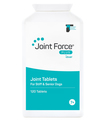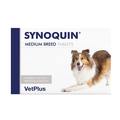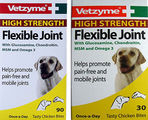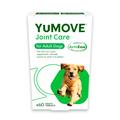Approximately 25% of dogs will suffer from osteoarthritis in their lifetime. This is where one or multiple joints are inflamed and painful - something which is most commonly due to aging. It’s not just our pet dogs that are affected either; in one study 90% of cats over the age of 12 had signs of osteoarthritis on x-ray.
How do I know if my pet has arthritis?
Early signs can be very subtle. Your pet might not want to walk as much, could be slowing down generally, or have difficulty getting up from lying down. Cats may have difficulty jumping or seem more lethargic than normal. In the later stages you may see your pet noticeably limping or vocalising in pain when moving the affected joint.
We don’t have to just let this happen. There are many easy ways to prevent this occurring in your pet, and also ways to help them stay comfortable if they already have the condition.
1) Joint supplements
-
These have ingredients that help with normal joint repair and function. It is best to choose a comprehensive supplement that contains multiple ingredients proven to help the joints.
-
Our own brand joint supplement, Joint Force, contains all your pet needs for joint health and support:
-
In the early stages of arthritis this may be enough to control the disorder alone.
-
It may also help prevent the problem occuring and is worth starting from an early age if you want to do all you can.
2) Pain relief
-
If joint supplements alone aren't enough, then consider adding in pain relief.
-
Ideally this is a Non-Steroidal Anti-Inflammatory Drug (NSAID), such as Meloxicam. These reduce inflammation in the joint.
-
Other veterinary licensed medications can also be added that are safe to use alongside NSAIDs if this isn't enough.
-
All medications will need to be supplied by prescription from your vet. Information on getting prescription meds through us can be found here.
3) Physiotherapy
-
It is good to keep the muscles around the affected areas active and strong. This helps to keep the joint in shape and takes some of the pressure off it.
-
Continue walks with your dog, but reduce the frequency or stop your dog running as much if they are often sore afterwards.
-
If you can, try hydrotherapy or physiotherapy with a specialist. Swimming helps your pet use and grow their muscles, whilst not putting pressure on the joint and worsening the disease. Your vet will be able to advise on local contacts.
4) Weight management
-
Ideally your pet should be a normal weight as excessive weight will predispose them to arthritis.
-
If your pet has arthritis, then keeping them slightly underweight is ideal. Weight adds pressure to the joints and worsens the disease.
-
See our blog for more information on working out if your pet is overweight, and specifics on weight management.
If you have any specific questions about arthritis in your pet please contact our customer services as we would love to help you further.
Written by: Dr. Nick Garside BVetMed MRCVS










